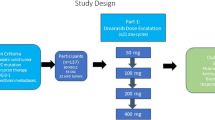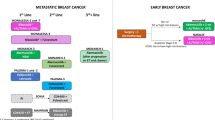Abstract
Capecitabine (Xeloda®) is a prodrug of 5-FU used in the clinical management of advanced breast cancer. It is metabolized first in the liver by carboxylesterases to generate 5′-deoxy-5-flurocytidine ribose (5′-DFCR), which is subsequently converted to 5′-deoxy-5-fluorouridine ribose (5′-DFUR) by cytidine deaminase in tumour and normal tissues. The conversion of 5′-DFUR to the cytotoxic 5-FU, occurs primarily in the tumour and is catalyzed by thymidine phosphorylase (TP). Prior work in head and neck cancer showed that cell treatment with an inhibitor of the epidermal growth receptor (EGFR) gefitinib led to an increase in TP expression and sensitized them to 5′-DFUR. This work seeks to investigate the factors influencing the potency of gefitinib + 5′-DFUR combination. Here, we studied these factors in a panel of six human breast cancer cell lines, with varied levels of sensitivity to gefitinib. Our results first confirmed that 5′-DFUR potency linearly correlates with TP basal levels in the panel of cell lines. In contrast, the strength of the synergistic effect of the gefitinib + 5′-DFUR combination, as measured by their combination indices (CI) correlates with pEGFR percent inhibition and with the modulation of TP expression by gefitinib (as quantitated by TP fold change) rather than TP basal levels. The results, in toto, suggest that the extent of modulation of TP by gefitinib may be used as a predictor of tumour sensitivity to gefitinib + capecitabine/5′-DFUR combinations.










Similar content being viewed by others
References
Rivera E (2010) Management of metastatic breast cancer monoheratpy options for patients resistant to anthracyclines and taxanes. Am J Clin Oncol 33:176–185
Cassata A, Procoplo G, Alu M, Ferrari L, Ferrario E, Beretta E, Longarini R, Busto G, De Candis D, Bajetta E (2001) Capecitabine: indications and future perspectives in the treatment of metastatic colorectal and breast cancer. Tumori 87:364–371
O’Shaughnessy J, Miles D, Vukelja S, Moiseyenko V, Ayoub JP, Cervantes G, Fumoleau P, Jones S, Lui WY, Mauriac L, Twelves C, Van Hazel G, Verma S, Leonard R (2002) Superior survival with capecitabine plus docetaxel combination therapy in anthracycline-pretreated patients with advanced breast cancer: phase III trial results. J Clin Oncol 20:2812–2823
Talbot DC, Moiseyenko V, Van Belle S, O’Reilly SM, Alba Conejo E, Ackland S, Eisenberg P, Melnychuk D, Pienkowski T, Burger HU, Laws S, Osterwalder B (2002) Randomised, phase II trial comparing oral capecitabine (Xeloda®) with paclitaxel in patients with metastatic/advanced breast cancer pretreated with anthracyclines. Br J Cancer 86:1367–1372
Miwa M, Ura M, Nishida M, Sawada N, Ishikawa T, Mori K, Shimma N, Umeda I, Ishitsuka H (1998) Design of a novel oral fluoropyrimidine carbamate, capecitabine, which generates 5-fluorouracil selectively in tumours by enzymes concentrated in human liver and cancer tissue. Eur J Cancer 34:1274–1281
Andreetta C, Puppin C, Minisini A, Valent F, Pegolo E, Damante G, Di Loreto C, Pizzolitto S, Pandolfi M, Fasola G, Piga A, Puglisi F (2009) Thymidine phosphorylase expression and benefit from capecitabine in patients with advanced breast cancer. Ann Oncol 20(2):265–271
Yu EJ, Lee Y, Rha SY, Kim TS, Chung HC, Oh BK, Yang WI, Noh SH, Jeung H-C (2008) Angiogenic factor thymidime phosphorylase increases cancer cell invasion activity in patients with gastric adenocarcinoma. Mol Cancer Res 6(10):1554–1566
Nishimura G, Terada I, Kobayashi T, Ninomiya I, Kitagawa H, Fushida S, Fujimura T, Kayahara M, Shimizu K, Ohta T, Miwa K (2002) Thymidine phosphorylase and dihydropyrimidine dehydrogenase levels in primary colorectal cancer show a relationship to clinical effects of 5-deoxy-5-fluorouridine as adjuvant chemotherapy. Oncol Rep 9:479–482
ZZ MaT, Ji YB, Zhang Y, Yu YY, Liu BY, Yin HR, Lin YZ (2004) Correlation of thymidylate synthase, thymidine phosphorylase and dihydropyrimidine dehydrogenase with sensitivity of gastrointestinal cancer cells to 5-fluorouracil and 5-fluoro-2′-deoxyuridine. World J Gastroenterol 10:172–176
De Angelis P, Svendsrud DH, Kravik KL, Stokke T (2006) Cellular response to 5-fluorouracil (5-FU) in 5-FU-resistant colon cancer cell lines during treatment and recovery. Mol Cancer 5:20
Carreras CWSD (1995) The catalytic mechanism and structure of thymidylate synthase. Annu Rev Biochem 64:721–762
Morse DLGH, Payne CM, Gillies RJ (2005) Docetaxel induces cell death through mitotic catastrophe in human breast cancer cells. Mol Cancer Ther 4:1495–1504
Ishitsuka H (2000) Capecitabine: preclinical pharmacology studies. Invest New Drugs 18:343–354
Nadella P, Shapiro C, Otterson GA, Hauger M, Erdal S, Kraut E, Clinton S, Shah M, Stanek M, Monk P, Villalona-Calero MA (2002) Pharmacobiologically based scheduling of capecitabine and docetaxel results in antitumor activity in resistant human malignancies. J Clin Oncol 20:2616–2623
Sawada N, Ishikawa T, Fukase Y, Nishida M, Yoshikubo T, Ishitsuka H (1998) Induction of thymidine phosphorylase activity and enhancement of capecitabine efficacy by taxol/taxotere in human cancer xenografts. Clin Cancer Res 4:1013–1019
Magne N, Fischel JL, Dubreuil A, Formento P, Ciccolini J, Formento JL, Tiffon C, Renee N, Marchetti S, Etienne MC, Milano G (2003) ZD1839 (Iressa) modifies the activity of key enzymes linked to fluoropyrimidine activity: rational basis for a new combination therapy with capecitabine. Clin Cancer Res 9:4735–4742
Geyer CE, Forster J, Lindquist D (2006) Lapatinib plus capecitabine for HER2-positive advanced breast cancer. N Engl J Med 355(26):2733–2743
Nair P (2005) Epidermal growth factor receptor family and its role in cancer progression. Curr Sci 88:890–898
Yarden Y, Shilo BZ (2007) SnapShot: EGFR signaling pathway. Cell 131(5):1018
Fischer OM, Hart S, Gschwind A, Ullrich A (2003) EGFR signal transactivation in cancer cells. Biochem Soc Trans 31(Pt 6):1203–1208
Lacroix M, Leclercq G (2004) Relevance of breast cancer cell lines as models for breast tumours: an update. Breast Cancer Res Treat 83(3):249–289
Ethier SP, Mahacek ML, Gullick WJ, Frank TS, Weber BL (1993) Differential isolation of normal luminal mammary epithelial cells and breast cancer cells from primary and metastatic sites using selective media. Cancer Res 53(3):627–635
Lasfargues EY, Coutinho WG, Redfield ES (1978) Isolation of two human tumor epithelial cell lines from solid breast carcinomas. J Natl Cancer Inst 61(4):967–978
Engel LW, Young NA (1978) Human breast carcinoma cells in continuous culture: a review. Cancer Res 38(11 Pt 2):4327–4339
Cailleau R, Olive M, Cruciger QV (1978) Long-term human breast carcinoma cell lines of metastatic origin: preliminary characterization. In Vitro 14(11):911–915
Chou T, Talalay P (1984) Quantitative analysis of dose-effects relationships: the combined effects of multiple drugs or enzyme inhibitors. Adv Enzyme Regul 22:27–55
Hamid R, Rotshteyn Y, Rabadi L, Parikh R, Bullock P (2004) Comparison of alamar blue and MTT assays for high through-put screening. Toxicol In Vitro 18(5):703–710
Acknowledgments
We would like to thank the Canadian Institute of Health Research for their financial support of the project (CIHR Operating Grant MOP-49440). In addition, we would like to express our gratitude to the Research Institute/McGill University Health Center and the McGill/Canadian Institute Health Research Drug development training Program for providing Maria Ait-Tihyaty with generous scholarships.
Conflict of interest
All authors declare that there are no conflicts of interest regarding this article.
Author information
Authors and Affiliations
Corresponding author
Rights and permissions
About this article
Cite this article
Ait-Tihyaty, M., Rachid, Z., Mihalcioiu, C. et al. Inhibition of EGFR phosphorylation in a panel of human breast cancer cells correlates with synergistic interactions between gefitinib and 5′-DFUR, the bioactive metabolite of Xeloda® . Breast Cancer Res Treat 133, 217–226 (2012). https://doi.org/10.1007/s10549-011-1756-z
Received:
Accepted:
Published:
Issue Date:
DOI: https://doi.org/10.1007/s10549-011-1756-z




